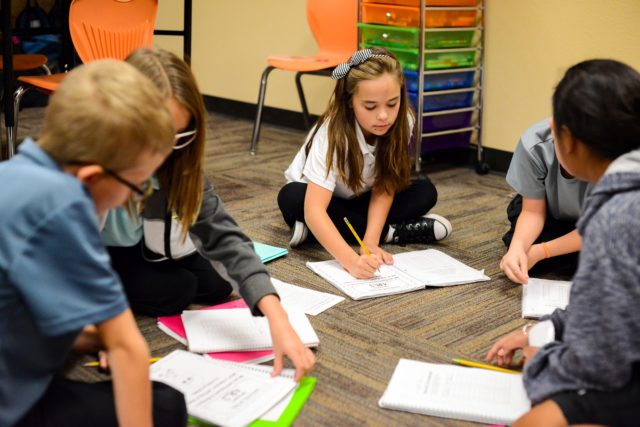The Impact of Active, Student-Centered Classrooms on Student Success
At Athlos Academies, we find it essential that classrooms are active and student-centered. Physical activity enhances the ability to learn, and students who are engaged are more excited to learn and more willing to take ownership of their learning. Creating active, student-centered classrooms is two-fold, meaning a focus on both incorporating movement into the classroom as well as assuring instructional practices place students at the center of learning.
Active, Student-Centered Classrooms
An active, student-centered classroom goes beyond the intentional addition of physical movement and benefits students in a multitude of ways.
 “It’s not just about movement breaks and free play, it’s about creating a classroom environment that produces active learners,” said Amy Dolan, education specialist at Athlos Academies. “This is where kids learn how to engage in academic discourse, practice active listening strategies, feel empowered to ask questions, and collaboratively construct understanding. Active learners don’t have to be physically active all the time, but their minds are fully engaged.”
“It’s not just about movement breaks and free play, it’s about creating a classroom environment that produces active learners,” said Amy Dolan, education specialist at Athlos Academies. “This is where kids learn how to engage in academic discourse, practice active listening strategies, feel empowered to ask questions, and collaboratively construct understanding. Active learners don’t have to be physically active all the time, but their minds are fully engaged.”
In a student-centered classroom, everything (the space, the lessons, etc.) is intentionally set up to meet the diverse needs of the students in that room. Active teaching strategies put students at the center of learning.
“It’s the students who are doing the most reading, writing, speaking, and listening,” Dolan said. “It’s not a place where the teacher lectures while kids absorb facts.”
Instead, teachers are guides or facilitators for students as they learn together. Teachers plan lessons and activities that will help students to construct their own understanding, making connections to real-world situations and previous learning.
“When kids have questions, they are honored. When kids struggle, teachers think creatively of ways to support them. When the class has a hard time focusing, the teacher knows it’s time for a movement break,” Dolan said.
The Non Active, Student-Centered Classroom
This differs from classrooms where teachers take a more lecture-focused approach to teaching for the majority of instruction. Lecture can be an effective way to present students with some information, but when used in the majority, students become bored and disengaged from the information being taught.
“In classrooms that are not active and student-centered, it’s hard for teachers to gauge who really understands, or the teacher mistakenly assumes that because they said something the students now know it,” Dolan said. “Students who learn differently, need more time to process, or are too shy to participate, often get left behind.”
The Benefits of Active, Student-Centered Classrooms
At Athlos, our goal is that all students are engaged and challenged throughout the day with active bodies and active minds. When teachers intentionally use strategies to engage all students in a classroom, everyone gets to participate in the learning — not just the brave few who raise their hands. Students practice Performance Character as they take risks together and learn from their mistakes. Each student knows that their voice is important and feels a sense of belonging in the classroom community and ownership over their own learning.
“When kids feel safe and respected, the learning can be more memorable and meaningful,” Dolan said. “Kids learn what it means to be active members of a learning community, not just a student in a classroom, which means they are learning skills that will be needed for success later in life — communication, collaboration, problem-solving, and so much more.”
More on the Athlos model.




Leave a Reply
Want to join the discussion?Feel free to contribute!